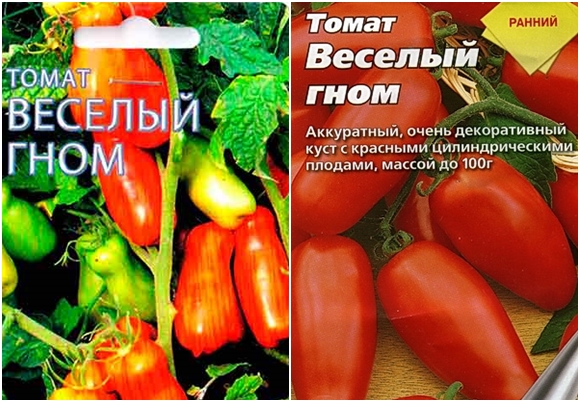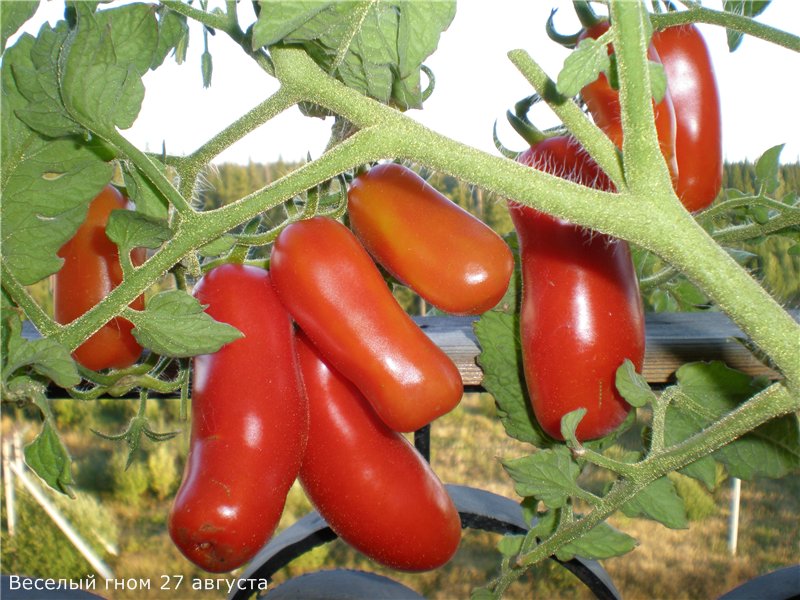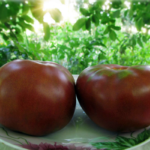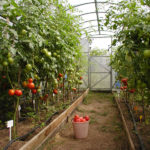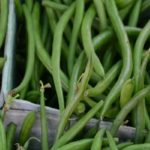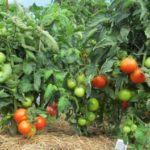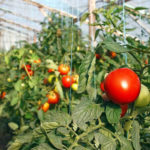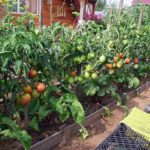A very nice tomato, the Cheerful Gnome, has fruits of an unusual, elongated, pepper-like shape. The variety is low-growing, high-yielding. The description of the miniature plant by gardeners speaks of its decorative merits. Bright red fruits hang on the branches, reminiscent of the caps of fairy-tale characters. Compact bushes are suitable for growing as a border plant, for flower beds, balconies, loggias, and window sills.
[toc]
Important! Early transplantation of seedlings into open ground is favorable for hardened plants. They quickly take root, evaporate less moisture through the leaf blade and begin to intensively grow the root system.
Main varietal features
The tomato variety “Jolly Dwarf” by Russian breeder Myazina, Candidate of Agricultural Sciences, is designed for short, cold summer conditions.
Main characteristics:
- the variety belongs to the category of early ripening and requires about 100 days from germination to full fruiting;
- The tomato is not tall, with a standard type of bush, a strong, erect stem 40 - 50 cm high. In any case, even when it grows by 10 - 15 cm, the “Jolly Dwarf” does without a garter;
- bush compact, determinate, sparsely leafy. This provides a number of advantages. You don’t have to waste time removing stepsons and forming a plant;
- leaves are ordinary, slightly corrugated, small, dark green;
- high-yielding variety. With compact plant sizes, 1.5 - 3 kg of tomatoes are collected from it;
- The fruits are cylindrical in shape, with ribs at the base. When fully ripe, the top of the tomato is pointed, like peppers;
- the skin of tomatoes is dense, shiny and smooth, bright red;
- tomato length is 10 - 12 cm, weight from 80 - 100 g. The largest specimens reach a weight of up to 135 - 140 g;
- the fruit has two chambers, inside of which there are seeds, with virtually no juice. The pulp itself is juicy, dense, aromatic, and sweet in taste.
Important! Fruits that do not have time to ripen are often harvested in a state of milk ripeness. The tomato must be removed from the bush with its stalk; when it is torn off, bacteria can penetrate into the resulting wound.
Universal tomatoes. They perform well in the process of canning, and due to their unusual shape they are ideally combined in whole-fruit pickles and marinades along with cucumbers and peppers.The pleasant sweet tomato taste is suitable for using fresh tomatoes for salads and making purees, soups, and stuffing.
Due to their low moisture content, tomatoes can be dried or dried. It should be noted that the seed material is of high quality. Seeds have a germination rate of 99 - 100%.
Rules for caring for the “Jolly Dwarf”
Determinate tomatoes with a standard bush are quite easy to care for. When growing them, it is customary to follow standard rules. Considering the characteristics of the variety, its resistance to low temperatures, diseases, short ripening times and a guaranteed yield of 1.5 kg, you can safely get down to business.
- It all starts with the seeds being disinfected in a weak solution of manganese, hardened in a refrigerator, and saturated with microelements by placing them in a “growth stimulator.”
- To obtain high-quality seedlings, a balanced composition of the soil mixture is important. The substrate must be loose, breathable and moisture-absorbing. It should be free of pests and pathogens. To do this, the earth is heated at 80-90 degrees.
- Seeds are planted 50 - 55 days before planting in the ground. This approximately occurs in early April.
- Seedlings dive into separate cups with the appearance of 1-2 true leaves. Lighting and temperature modes are selected individually, depending on the condition of the plants. Water the seedlings moderately, trying to maintain soil moisture at 70 - 80%.
- Plants are planted in the ground after the end of spring frosts in May. If seeds and mature seedlings are hardened in a timely manner, then the plant can be planted in a permanent place 10 days earlier.
- Compact tomatoes grow well in dense plantings, according to a 30 x 30 pattern.Care comes down to fertilizing, watering, timely weeding and loosening the soil.
Released early ripening varieties usually cause little trouble. Caring for them is simple, but the “Jolly Gnome” brings so much joy once it appears on the dining table. It is noticeably different from traditional round tomatoes, always attracting everyone's attention.

